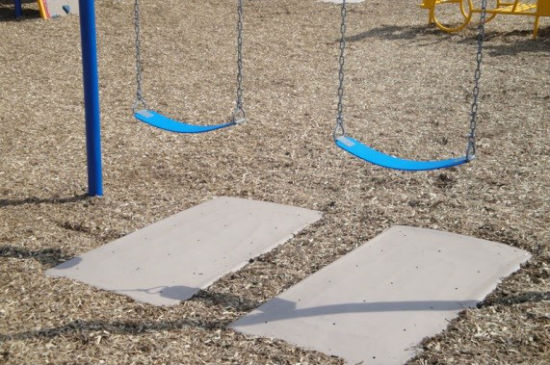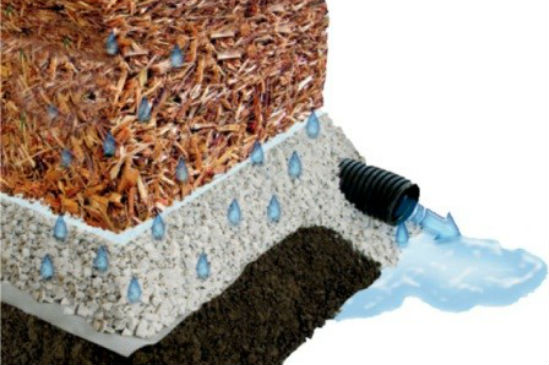1. What are the pros and cons of the different types of surfacing (loose fill, unitary)?
Loose fill surfaces such as EWF (engineered wood fiber) are generally less expensive, do not require professional installation, drain well and on average give greater fall height protection than unitary surfaces. The drawback is more maintenance is needed since loose surfaces are just that – loose! So they tend to scatter in high use areas and need raked, leveled and replenished periodically in order to keep them safe and accessible which increases maintenance costs.
Unitary surfaces such as PIP, tiles and turf have more upfront material & installation costs, require professional installation, can be extremely hot during summer months and generally do not have the same impact resiliency as loose fill products especially as they get older. However, they do not require a lot of maintenance so they are desirable for those that have high budgets and limited help to maintain their playgrounds and usually have longer warranties on materials except in areas that are considered high use such as swings and slide exits. Ask for warranty details before purchasing.
2. What are the maintenance requirements of playground surfaces?
Loose fill surfaces need to be maintained especially in high use areas such as swings, slide exits, spinner toys, and entrances/ exits to the play area. If these areas are not maintained, you end up with divots and holes under high-use impact zones and this can be a hazard as well as making the play area inaccessible. Many owners forget that loose fill surfaces also compact from their original installed thickness and eventually you can have a drop off from a surrounding border which could make access to their playgrounds practically impossible. You can either top off the surface with more surfacing to bring the levels back up or ask the manufacturer if they offer wear mats for these high-use zones and access ramps to make a more permanent entrance and exit into and out of the play area.
These kinds of ‘accessories’ can reduce maintenance costs and help you get more out of your purchase!
Unitary surfaces do not have the maintenance needs that loose fill surfaces do but keeping them clean is essential to getting the most out of them. Periodically blow them off and clean up spills when they occur. Pay close attention to the high use areas as these areas may need patched periodically or if using artificial turf that relies on rubber infill for impact attenuation, be sure the infill is replenished to whatever the manufacturer specifies for the particular height of the equipment. Since unitary surfaces may become harder over time, it’s a very good idea to get a company to come out and perform a drop test using an approved impact testing device that can give proper Gmax and HIC (head injury criteria) readings. (Zeager offers this service). Unitary surfaces may appear ‘okay’ from the naked eye, but you don’t know what is going on beneath the top color layer as the buffing’s layer will become less resilient as time goes on.
3. What is the most important factor in maintaining playground surfaces and ensuring playground safety?
Have a plan! Maintaining surfaces whether loose fill or unitary is not rocket science. The problem I see is some playground owners just don’t take the time to put a schedule together to make sure they are inspecting their playgrounds on a regular basis. Sending a couple of their workers to a playground safety inspector course to learn how to inspect a playground properly can really help a maintenance supervisor since they can’t be everywhere all at once. Also, ask what the manufacturer recommends on how to maintain the surface you purchased. The manufacturer will know best on how to maintain their surface properly.
4. What are some common causes of unsafe surfaces?
I would say the most common cause for unsafe surfaces would be lack of maintenance and education about the particular type of surface they are using. The best thing a playground owner can do is to do their homework about what will be needed for their surfacing and then come up with a program to maintain it. If it’s a loose fill surface that they are going to install themselves, get installation instructions from the vendor and follow them. Some vendors may require certain installation techniques to give better accessibility or recommend other products like wear mats to reduce maintenance. Check to be sure you use the recommended thickness of the surface for the fall height required. Make a mark on the equipment post so you can see when the surface needs topped off.
Some synthetic manufacturers may recommend an impact test every so often to make sure the surface is still impact resilient. The surface may look good on the top but if it has begun to decay beneath the wear layer it may not be safe and the only way to determine that is to perform a drop test. There are many playgound consulting companies that offer this.
You wouldn’t think drainage would lend to a surfaces safety, but it does! Imagine a loose fill surface that doesn’t drain well in a cold climate where temperatures fluctuate, causing snow to melt and then re-freeze overnight. Any amount of frozen moisture that is within the surface makes the surface less resilient and unable to provide good impact attenuation so eliminating water from the surface will minimize this and help the surface to last longer too.
5. What should you consider when choosing a playground surface?
Consider your budget. It’s easy to say “let’s put a unitary surface in so we can lower our maintenance costs” but unitary surfaces range from $14 to $20 a square foot while a loose fill surface such as engineered wood fiber is only about $1.50 to $3.00 a square foot. For some large school districts and municipalities that have literally hundreds of playgrounds, it’s easier to top-off and maintain the playground on a weekly or monthly basis then forking out a large sum of money and draining their budget.
6. How do you determine what is the best type of surface material?
Let’s be honest here, there is no perfect surface! A surface should be the total package – Safe, accessible, affordable, and available. So, let’s take them one at a time; Safe: ask the manufacturer for recent impact test results per ASTM F1292 (within a few years) and if they have any test results from an actual installation out in the field. Are the numbers on the edge of failing or is there plenty of room in case of harsh weather which could affect the resiliency of the surface. If using EWF ask for test results for ASTM F2075 which checks for sieve analysis, trammels like nails and staples and hazardous metals like Lead, Mercury and Arsenic. Accessible; Get a recent ASTM F1951 test result showing it passes for accessibility but also see if the vendor has any installation instructions or maintenance recommendations to keep their surface accessible. If you can maintain it, you can rest assured you’ll meet ADA guidelines. Affordable; When it comes to affordability, look at all angles. Can I afford it upfront without blowing up my budget as well as can I afford to maintain it so I have a safe, accessible surfacing. Availability? No, I don’t mean whether the surface is actually available. Any vendor can sell you something. I mean, will you have the support available when you need it, will the vendor be there when you need to know how to get the most out of your purchase or when there is a warranty issue. Most playground owners don’t have the time to chase down a vendor and then get the run around when it comes to questions and answers to the product they purchased. They want their vendor or manufacture available when something pops up.
7. How often should regular safety inspections be done on playground surfaces?
That depends on the type of surface used and how detailed of an inspection you want to do. We recommend for engineered wood fiber a general, weekly & monthly inspection where you would check on high traffic areas such as entrance and exits of equipment to be sure there is sufficient depth of surface. Rake level, top off as needed. If you have wear mats installed, check to make sure the transition from mat to surface is level. Then on a monthly basis you may want to dig down in the fall zones to be sure ample depth is there to give optimum fall protection. We recommend installing more than enough thickness of surface than is actually needed so that you have time in between inspections when you can’t be there on a frequent basis. Most swings for instance are 8 feet at the pivot point but we recommend placing 12” in these areas which will give over 30% more fall protection. If wear mats are used in the high traffic areas, replenish the surfacing beneath them, then reinstall the mat. Also check the drainage periodically to be sure it is working. A soaked surface could freeze and not provide proper fall protection in cold climates. Poor drainage hastens decomposition too. This can easily be done by inspecting the water pipe outlet after a hard rain. If the drainage pipe is not visible, dig down to the drainage layer, place a pipe over the drainage with a little silicone caulk to seal the pipe edge, and pure water down the pipe. The water should disappear into the drainage layer relatively quickly. For unitary surfaces, inspections can be done on a less frequent basis. But one thing to keep in mind as a unitary surface such as poured in place or rubber tiles gets older, they tend to be less resilient so even though it may look good on the surface, request a drop test in various spots after 3 years and then every couple years thereafter to be sure the surface is still resilient. Some manufactures may offer this service as part of the total package.





